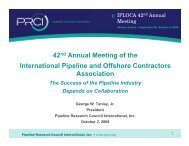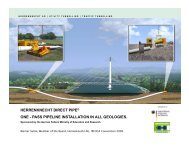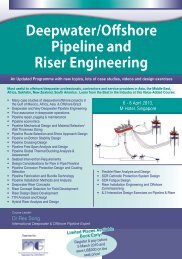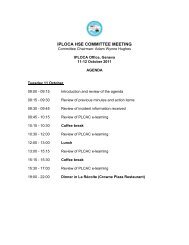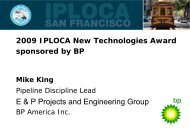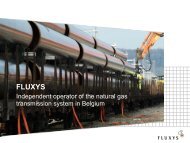EPRG-PRCI-APIA 17th JOINT TECHNICAL MEETING ON ... - Iploca
EPRG-PRCI-APIA 17th JOINT TECHNICAL MEETING ON ... - Iploca
EPRG-PRCI-APIA 17th JOINT TECHNICAL MEETING ON ... - Iploca
Create successful ePaper yourself
Turn your PDF publications into a flip-book with our unique Google optimized e-Paper software.
The aim of the project is to provide operators with definitive guidelines on how to respond<br />
when their offshore pipeline is damaged; what pressure reduction is appropriate, what<br />
parameters are important when addressing damage, what epair strategies can be<br />
considered. The guidance will initially be based on existing company best practice, followed<br />
by research to address any identified gaps.<br />
<strong>EPRG</strong> Projects 135, 140, 147: Burst strength of pipes containing dent + gouge<br />
damage<br />
The method currently recommended by <strong>EPRG</strong> for assessing the remaining strength of pipes<br />
with such damage is based on the ‘British Gas Model’ developed in the early 1980s using a<br />
combination of fracture mechanics and empirical relationships derived from a database of<br />
122 experimental tests.<br />
A recent study for the United Kingdom Onshore Pipeline Association (UKOPA) developed an<br />
improved limit state function to address some of the perceived shortcomings of the British<br />
Gas Model, notably the stress concentration and residual stresses associated with the dent,<br />
and the micro-cracking at the base of the gouge. Recognising the potential for further<br />
developing and improving the predictive model, <strong>EPRG</strong> commissioned a study applying the<br />
UKOPA model to the wider set of 224 test results now available in the public domain,<br />
enabling recalibration and further refinement of the factors determining failure behaviour.<br />
This confirmed that differences between the methods used for simulating the dent+gouge<br />
damage in the experimental tests were responsible for much of the extensive scatter still<br />
evident in the predictions.<br />
A subsequent <strong>EPRG</strong> study has examined in more detail the factors identified during the<br />
recalibration study. While a significant reduction in scatter and bias can be achieved for<br />
individual datasets by refining the definitions of toughness and micro-crack depth, the<br />
improvements are still masked by the variations between different datasets.<br />
<strong>EPRG</strong> Project 137, JTM Paper 30: The assessment of delayed fracture under constant<br />
pressure<br />
Recent events in Belgium have shown that modern steel can sustain quite significant defects<br />
that might go undetected and as a result may give significant consequences because of<br />
stable crack growth. For older steel, even in the case of low ductility material, some timedelayed<br />
failures have been recorded. Qualitative models developed in the past indicate that<br />
only a complex combination of parameters will lead to delayed failure. The aim of the project<br />
is to evaluate the sensitivity of time-delayed failure to pipe diameter, wall thickness,<br />
toughness and operating pressure, including pressure fluctuations due to normal pipeline<br />
operation.<br />
<strong>EPRG</strong> Projects 129, 139, 151: Hostile environmental effects on residual mechanical<br />
resistance of damaged pipes<br />
Mechanical damage due to excavator impact usually results in damage to the pipeline<br />
coating. In this situation, cathodic over-protection can be present and a potentially hydrogen<br />
charging environment can be created at the damage location. Among the <strong>EPRG</strong> members,<br />
five pipeline incidents were identified in which a combination of mechanical damage and<br />
cathodic over-protection could lead to rapid failure due to hydrogen embrittlement.<br />
<strong>EPRG</strong> commissioned an experimental project to explore how the effect can be simulated<br />
and measured in laboratory tests. The work utilised test specimens cut from the wall of<br />
pipes containing artificial dent and dent+gouge damage, and subjected them to a variety of<br />
monotonic and cyclic load tests, with and without corrosive liquid environments and cathodic<br />
over-protection.<br />
The results of these studies have qualitatively confirmed the effects seen in service; they<br />
have also pointed to the need for testing full pipe sections rather than laboratory specimens.<br />
Further experimental work is planned in order to pursue these issues.<br />
See also in the JTM Programme booklet:<br />
Paper 24: The pipeline defect assessment manual – R&D needs



